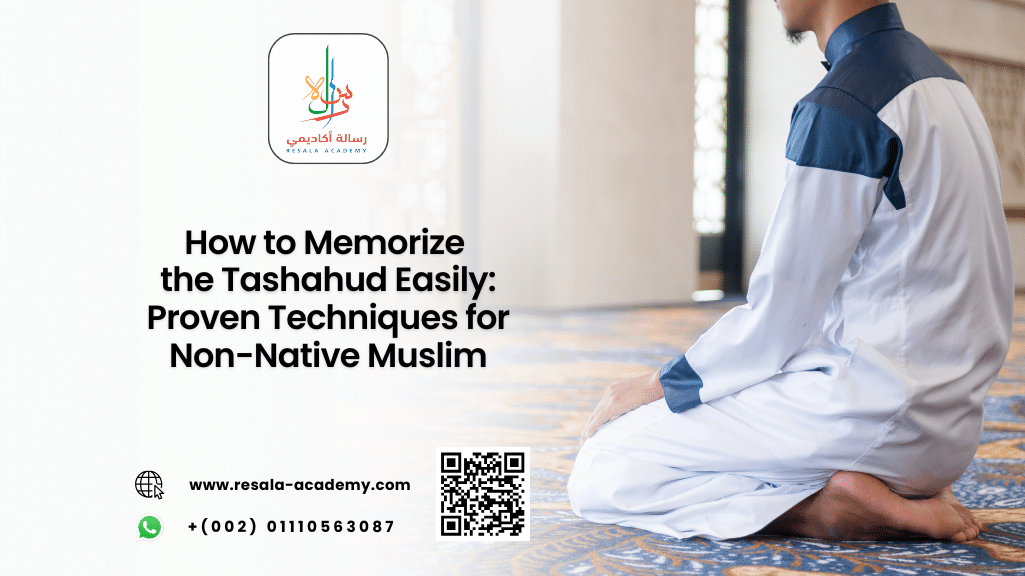Table of Contents
How to Memorize the Tashahud Easily: Proven Techniques for Non-Native Muslims
Learning and memorizing the Tashahud—a vital part of the Muslim prayer—is a spiritual milestone for every believer. For non-native Arabic speakers, however, this task can seem daunting.
This article is designed to guide you through practical, proven, and spiritually enriching techniques to help you memorize the Tashahud easily and deepen your connection with the words you recite in your daily prayers.
Whether you’re a beginner in Arabic or looking to perfect your prayer recitation, this guide is tailored to help you succeed. We’ll also introduce you to Resala Academy, a trusted online platform dedicated to teaching Arabic and the Quran to non-native speakers.
What is the Tashahud?
The Tashahud (التشهد) is a fundamental supplication recited during the sitting position of the Islamic prayer (Salah). It includes the testimony of faith and salutations upon the Prophet Muhammad ﷺ. It is recited in the second and final rak’ahs of the prayer.
Arabic Text of the Tashahud:
(التَّحِيَّاتُ لِلَّهِ وَالصَّلَوَاتُ وَالطَّيِّبَاتُ ، السَّلَامُ عَلَيْكَ أَيُّهَا النَّبِيُّ وَرَحْمَةُ اللَّهِ وَبَرَكَاتُهُ ، السَّلامُ عَلَيْنَا وَعَلَى عِبَادِ اللَّهِ الصَّالِحِينَ ، أَشْهَدُ أَنْ لا إِلَهَ إِلا اللَّهُ ، وَأَشْهَدُ أَنَّ مُحَمَّدًا عَبْدُهُ وَرَسُولُهُ. اللَّهُمَّ صَلِّ عَلَى مُحَمَّدٍ وَعَلَى آلِ مُحَمَّدٍ ، كَمَا صَلَّيْتَ عَلَى إِبْرَاهِيمَ وَعَلَى آلِ إِبْرَاهِيمَ ، إِنَّكَ حَمِيدٌ مَجِيدٌ ، اللَّهُمَّ بَارِكْ عَلَى مُحَمَّدٍ وَعَلَى آلِ مُحَمَّدٍ ، كَمَا بَارَكْتَ عَلَى إِبْرَاهِيمَ وَعَلَى آلِ إِبْرَاهِيمَ ، إِنَّكَ حَمِيدٌ مَجِيدٌ)
English Translation:
“All compliments, prayers, and pure words are due to Allah. Peace be upon you, O Prophet, and the mercy of Allah and His blessings. Peace be upon us and the righteous slaves of Allah. I bear witness that there is no god except Allah and that Muhammad is His slave and Messenger. O Allah, send prayers upon Muhammad and the family of Muhammad, as You sent prayers upon Ibrahim and the family of Ibrahim. You are indeed Worthy of Praise, Full of Glory. O Allah, bless Muhammad and the family of Muhammad as You blessed Ibrahim and the family of Ibrahim, You are indeed Worthy of Praise, Full of Glory.”
Transliteration
Al-Tahiyyatu Lillahi wa’l-salawatu wa’l-tayyibat. Al-salamu ‘alayka ayyuha’l-Nabiyyu wa rahmat-Allahi wa barakatuhu. Al-salamu ‘alayna wa ‘ala ‘ibad-illah il-salihin. Ash-hadu an la ilaha ill-Allah wa ash-hadu anna Muhammadan ‘abduhu wa rasuluh. Allahumma salli ‘ala Muhammad wa ‘ala ali Muhammad kama salayta ‘ala Ibrahim wa ‘ala ali Ibrahim , innaka hamidun majid. Allahumma barik ‘ala Muhammad wa ‘ala ali Muhammad kama barakta ‘ala Ibrahim wa ‘ala ali Ibrahim, innaka hamidun majid.
This beautiful declaration is not just a ritual; it is a moment of deep spiritual connection between the worshipper and the Divine.
Quranic and Hadith Evidences Supporting the Tashahud
From the Sunnah:
The Prophet Muhammad ﷺ taught the Tashahud to his companions. One narration from Abdullah ibn Mas’ud (رضي الله عنه) states:
“Whenever we prayed behind the Prophet (ﷺ), we used to recite (in sitting) ‘Peace be on Gabriel, Michael, peace be on so and so. Once Allah’s Messenger (ﷺ) looked back at us and said, ‘Allah Himself is As-Salam (Peace), and if any of you prays, then he should say, at-Tahiyatu li l-lahi wa ssalawatu wa t-taiyibat. As-salamu `alalika aiyuha n-Nabiyu wa rahmatu l-lahi wa barakatuh. Assalamu `alaina wa `ala `ibadi l-lahi s-salihin. (All the compliments, prayers, and good things are due to Allah; peace be on you, O Prophet, and Allah’s mercy and blessings [be on you]. Peace be on us and the pious subjects of Allah. (If you say that, it will reach all the subjects in heaven and the earth.) Ash-hadu al-la ilaha illa l-lah, wa ash-hadu anna Muhammadan `Abduhu wa Rasuluh. (I testify that there is no Deity [worthy of worship] but Allah, and I testify that Muhammad is His slave and His Apostle).
إِنَّ اللَّهَ هُوَ السَّلاَمُ، فَإِذَا صَلَّى أَحَدُكُمْ فَلْيَقُلِ التَّحِيَّاتُ لِلَّهِ، وَالصَّلَوَاتُ وَالطَّيِّبَاتُ، السَّلاَمُ عَلَيْكَ أَيُّهَا النَّبِيُّ وَرَحْمَةُ اللَّهِ وَبَرَكَاتُهُ، السَّلاَمُ عَلَيْنَا وَعَلَى عِبَادِ اللَّهِ الصَّالِحِينَ. فَإِنَّكُمْ إِذَا قُلْتُمُوهَا أَصَابَتْ كُلَّ عَبْدٍ لِلَّهِ صَالِحٍ فِي السَّمَاءِ وَالأَرْضِ، أَشْهَدُ أَنْ لاَ إِلَهَ إِلاَّ اللَّهُ، وَأَشْهَدُ أَنَّ مُحَمَّدًا عَبْدُهُ وَرَسُولُهُ
Reference: Sahih al-Bukhari 831
From the Quran:
While the exact Tashahud is not found in the Quran, its components are deeply rooted in Quranic teachings. For example:
- Shahada:
“أشهد أن لا إله إلا الله”
“There is no deity except Allah.”
Quran 3:18 — “شَهِدَ اللَّهُ أَنَّهُ لَا إِلَٰهَ إِلَّا هُوَ” - Salutations upon the Prophet:
“Indeed, Allah and His angels send blessings upon the Prophet…”
Quran 33:56 — “إِنَّ اللَّهَ وَمَلَائِكَتَهُ يُصَلُّونَ عَلَى النَّبِيِّ”
These references show the spiritual and scriptural depth of the Tashahud.
How Should the Finger Be During Tashahud? A Sunnah Gesture with Deep Meaning
The physical posture and gestures during Salah are not arbitrary; they are rooted in the Sunnah of the Prophet Muhammad ﷺ. One such gesture is the movement of the index finger during the Tashahud, which holds both spiritual and symbolic significance.
Understanding how to properly position and move the finger during this part of the prayer enhances both your focus and adherence to authentic practice.
Here’s a breakdown of the correct Sunnah-based method regarding the finger during Tashahud:
- Raise the Right Index Finger: While seated in the final position of Salah (Tashahud), raise your right index finger when you reach the testimony of faith: “أشهد أن لا إله إلا الله”.
- Keep the Other Fingers Folded: The remaining fingers of the right hand should be closed into a fist, with the thumb touching the middle finger, forming a circle.
- Point Without Excessive Movement: According to authentic narrations, the Prophet ﷺ would point with his index finger during the Tashahud without excessive movement. Some scholars allow a slight motion, while others suggest keeping it still.
- Focus on Tawheed: The gesture symbolizes the oneness of Allah (Tawheed), reinforcing the meaning of the words being recited.
- Hadith Evidence: It is narrated in Sahih Muslim:
عَنِ ابْنِ عُمَرَ، أَنَّ النَّبِيَّ صلى الله عليه وسلم كَانَ إِذَا جَلَسَ فِي الصَّلاَةِ وَضَعَ يَدَيْهِ عَلَى رُكْبَتَيْهِ وَرَفَعَ إِصْبَعَهُ الْيُمْنَى الَّتِي تَلِي الإِبْهَامَ فَدَعَا بِهَا وَيَدَهُ الْيُسْرَى عَلَى رُكْبَتِهِ الْيُسْرَى بَاسِطُهَا عَلَيْهَا .
Ibn ‘Umar reported that when the Messenger of Allah (ﷺ) sat for tashahhud, he placed his left hand on his left knee. And his right hand on his right knee. And he raised his right finger, which is next to the thumb, making supplication in this way, and he stretched his left hand on his left knee.
This simple yet profound act during Tashahud is a reminder of the unity of Allah and the central message of Islam. Practicing it correctly adds to your khushu’ (concentration) and aligns your prayer with the Sunnah.
What Happens If You Forget to Recite Tashahud? Understanding the Ruling and Remedy
Forgetting to recite the Tashahud—whether the first or the final—can happen, especially to new Muslims or non-native Arabic speakers. However, Islam offers practical and merciful solutions for such situations. Here’s a detailed guide on what to do if you forget the Tashahud during prayer:
If You Forget the First Tashahud (After Two Rak’ahs):
- Continue the prayer without sitting for the first Tashahud.
- Perform Sujood al-Sahw (prostration of forgetfulness) at the end of the prayer before or after the Tasleem, depending on your school of thought.
- This is based on the Hadith:
أَنَّ النَّبِيَّ صلى الله عليه وسلم صَلَّى بِهِمُ الظُّهْرَ فَقَامَ فِي الرَّكْعَتَيْنِ الأُولَيَيْنِ لَمْ يَجْلِسْ، فَقَامَ النَّاسُ مَعَهُ حَتَّى إِذَا قَضَى الصَّلاَةَ، وَانْتَظَرَ النَّاسُ تَسْلِيمَهُ، كَبَّرَ وَهْوَ جَالِسٌ، فَسَجَدَ سَجْدَتَيْنِ قَبْلَ أَنْ يُسَلِّمَ ثُمَّ سَلَّمَ.
“Once the Prophet (ﷺ) led us in the Zuhr prayer and stood up after the second rak`a and did not sit down. The people stood up with him. When the prayer was about to end and the people were waiting for him to say the Taslim, he said Takbir while sitting and prostrated twice before saying the Taslim, and then he said the Taslim.”
— Sahih al-Bukhari 829
If You Forget the Final Tashahud:
- If you remember before completing the prayer with Tasleem, sit back down and recite the Tashahud.
- If you remember after Tasleem, scholars differ:
- Some say the prayer is valid, but Sujood al-Sahw should be performed.
- Others recommend repeating the prayer if a significant portion was missed.
- Always consult a qualified scholar or teacher for clarification.
Preventative Tips:
- Recite your Salah slowly and mindfully.
- Practice the Tashahud regularly outside of prayer.
- Use learning aids like audio recitations and visual flashcards.
- Enroll in structured courses like those offered by Resala Academy, where you receive step-by-step guidance on perfecting your Salah.
Understanding the rulings related to the Tashahud ensures that your prayer remains valid and spiritually fulfilling. Mistakes are natural, but Islam provides clear and forgiving remedies to uphold the sanctity of worship.
Why Memorizing the Tashahud is Important
Memorizing the Tashahud is essential because:
- It is a required part of the Salah (prayer), one of Islam’s five pillars.
- It includes the Shahada (testimony of faith), the core of Islamic belief.
- It connects the believer to the Prophet Muhammad ﷺ through salutations.
- It enhances khushu’ (concentration and humility) in prayer when understood and recited with meaning.
Proven Techniques to Memorize the Tashahud Easily
Learning a new language or memorizing a new text can be challenging, but with the right techniques, it becomes achievable and even enjoyable.
1. Break It Down Into Sections
Divide the Tashahud into smaller, manageable parts. For example:
- التحيات لله، والصلوات والطيبات
- السلام عليك أيها النبي ورحمة الله وبركاته
- السلام علينا وعلى عباد الله الصالحين
- أشهد أن لا إله إلا الله
- وأشهد أن محمدًا عبده ورسوله
Memorize one line at a time, then gradually add the next.
2. Listen and Repeat
Use audio resources from trusted Islamic platforms like Quran.com or IslamicFinder to hear the correct pronunciation. Repetition is key.
- Listen to the Tashahud daily.
- Repeat after the reciter.
- Record yourself and compare.
3. Use Visual Aids
Write the Tashahud in Arabic and its transliteration. Use flashcards or sticky notes around your home. Visual cues help reinforce memory.
4. Practice During Prayer
Integrate what you’ve memorized into your daily Salah. Even if you haven’t memorized the entire Tashahud yet, recite what you know and build from there.
5. Understand the Meaning
Understanding the meaning of each phrase enhances memory retention. When you know what you’re saying, your brain connects the words to emotions and concepts, making them easier to recall.
Deepen your spiritual connection—discover why learning Arabic for prayer online is a vital step for every Muslim seeking a more meaningful and authentic worship experience.
Resala Academy: Your Gateway to Mastering Arabic and the Quran
If you’re a non-native speaker struggling to memorize the Tashahud or any other part of the prayer, Resala Academy is here to help. As a premier online Quran academy, Resala offers:
📖 Live Arabic and Quran classes with native Arabic-speaking teachers.
🧕 Tailored programs for children and adults.
🎯 Focused memorization techniques for Salah, Quran, and Duas.
💻 Flexible schedules for learners across the globe.
Why Choose Resala Academy?
✅ Certified and experienced instructors.
✅ One-on-one sessions to ensure personalized attention.
✅ Affordable pricing with trial classes.
✅ A supportive community of learners.
👉 Join Resala Academy today and take your first step toward mastering your prayer and understanding the language of the Quran.
Tips for Non-Native Speakers
Here are some additional tips specifically for non-native Arabic learners:
- Use transliteration initially, but aim to transition to Arabic script.
- Practice with a partner or teacher to improve pronunciation.
- Set daily goals—even 5 minutes a day can yield results.
- Celebrate small wins—every verse memorized is a victory.
Frequently Asked Questions (FAQs)
1. How long does it take to memorize the Tashahud?
It varies by individual, but with consistent daily practice (10–15 minutes), most learners can memorize it within 1–2 weeks.
2. Can I recite the Tashahud in English during prayer?
According to most scholars, the Tashahud must be recited in Arabic during obligatory prayers. However, during the learning phase, you may recite what you know while continuing to learn.
3. What if I make mistakes while reciting the Tashahud?
Minor mistakes that do not change the meaning are generally excused. However, it’s important to strive for accuracy. Consider enrolling in a class at Resala Academy to perfect your recitation.
4. Is the Tashahud the same in all schools of thought?
The core content is the same, but slight variations exist among the different madhhabs (schools of thought). The version mentioned here is widely accepted.
5. Can children learn the Tashahud?
Absolutely! Children often memorize faster than adults. Resala Academy offers specialized programs for children to learn Arabic, Quran, and prayers in a fun and engaging way.
Summary
Memorizing the Tashahud is a beautiful journey that strengthens your connection with Allah and the Prophet Muhammad ﷺ. With the right techniques—breaking it down, repetition, understanding the meaning, and consistent practice—you can master it with ease.
For non-native speakers, the journey may seem challenging, but with support from platforms like Resala Academy, it becomes a rewarding spiritual experience. Whether you’re learning for the first time or revisiting your recitation, remember that every effort you make is rewarded by Allah.
Final Thoughts
Prayer is the heartbeat of a Muslim’s life, and the Tashahud is its soul. By memorizing and understanding it, you not only fulfill a religious obligation but also deepen your spiritual awareness.
Let your journey begin today—with sincerity, consistency, and the right guidance.
Ready to Master the Tashahud?
Take the next step in your spiritual journey with Resala Academy. Whether you’re a beginner or looking to improve your Arabic and Quranic knowledge, Resala offers the tools, teachers, and techniques to help you succeed.
Start your free trial now and experience the joy of learning the language of the Quran!




